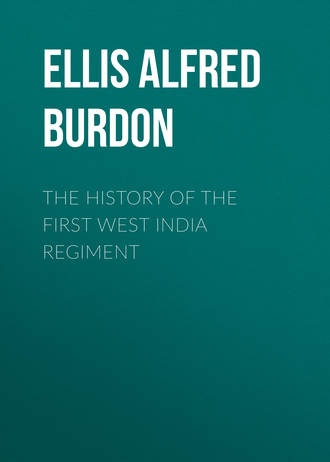 полная версия
полная версияThe History of the First West India Regiment
During its three years' tour of West African service the regiment had suffered very heavy loss amongst the officers. In addition to the eight deaths that occurred in 1874, directly after the Ashanti war, Captain W. Cole died in Ireland of fever contracted on the Gold Coast; Lieutenant-Colonel Strachan and Sub-Lieutenant Turner in England; and Sub-Lieutenants S.B. Orr and G.V. Harrison at Sierra Leone in 1876.
The regiment remained without change in the West Indies until December, 1879, when the head-quarters and six companies embarked in H.M.S. Tamar for West Africa, leaving D, E, and I Companies at the depôt at Demerara. The head-quarters and four companies disembarked at Sierra Leone on the 17th of January, 1880, and the two remaining companies proceeded to Cape Coast Castle.
In February, 1880, there being some slight disturbance in the neighbourhood of the Ribbie River, a small party of the 1st West India Regiment proceeded thither as an escort to the Governor, with Lieutenants Madden and Tipping. The whole returned to Sierra Leone without any casualty, after an absence of a few weeks.
On the 28th of January, 1881, news was received at Sierra Leone that the Ashanti king, Mensah, had threatened an invasion of the Gold Coast Colony, and a reinforcement was urgently demanded. In consequence, Captain H.W. Pollard, 1st West India Regiment, commanding the troops on the West Coast of Africa, despatched to Cape Coast Castle next day in the mail steamer Cameroon letter B Company, under Captain Ellis, and letter H Company, under Lieutenant Garland. These two companies arrived at their destination on the 2nd of February, and on the 9th the former proceeded to Anamaboe. This rapid arrival of reinforcements induced the king to repudiate the action of his envoys, but affairs were still in a very critical situation, and much alarm prevailed in the colony. Early in March, Lieutenant-Colonels Niven and Smith and Major White arrived from England, bringing with them letter A Company from Sierra Leone. On the 18th of March, five companies of the 2nd West India Regiment arrived in the hired transport Humber. Negotiations were protracted till April, when an embassy arrived from Coomassie, and the difficulty was finally settled. On the 2nd of May, the head-quarters, with A, F, and G Companies, returned to Sierra Leone, leaving B, C, and H at Cape Coast Castle and Anamaboe. In February, 1882, C Company also proceeded to Sierra Leone.
It was intended at the termination of the African tour of the regiment, in January, 1883, to reduce the garrisons in West Africa from six to three companies, and the steamship Bolivar was chartered to carry out the relief in two trips. That vessel, however, was wrecked off the Cobbler's Reef, at Barbados, and H.M.S. Tyne was sent in her place. The latter embarked H Company at Cape Coast Castle on the 6th of February, 1883, and F and G Companies at Sierra Leone on the 14th, all three proceeding to Jamaica under the command of Major C.J.L. Hill. On the return of the Tyne to West Africa with three companies of the 2nd West India Regiment, the head-quarters and remaining three companies of the 1st West India Regiment, at Cape Coast Castle and Sierra Leone, were embarked on the 1st and 11th of April respectively, and sailed for Jamaica under the command of Captain Ellis, arriving at their destination on the 28th of April. On the 5th of May, B, G, and F Companies embarked in the Tyne, the first two for Honduras and the third for Nassau. On the conclusion of the inter-island trooping, the Tyne proceeded with the head-quarters and three companies of the 2nd West India Regiment to West Africa, the Government having, in consequence of threatened complications with Ashanti, abandoned their scheme of reducing the African garrisons.
The distribution of the 1st West India Regiment is now (May, 1883): Head-quarters and three companies (A, C, and H) at Jamaica, two (B and G) in Honduras, one (F) in Nassau, and three (D, E, and I) in Demerara.
APPENDIX
Succession of Honorary Colonels.
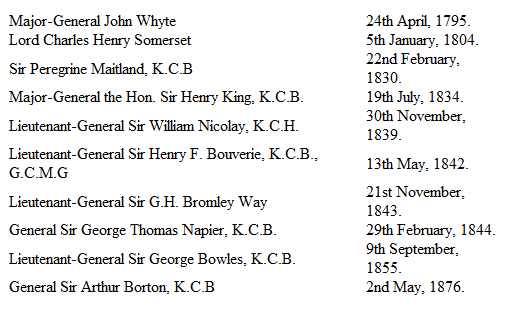
Succession of Lieutenant-Colonels.


(Lieutenant-Colonel Clifton retired, Jan. 23rd 1819, and the second Lieutenant-Colonelcy was abolished.)

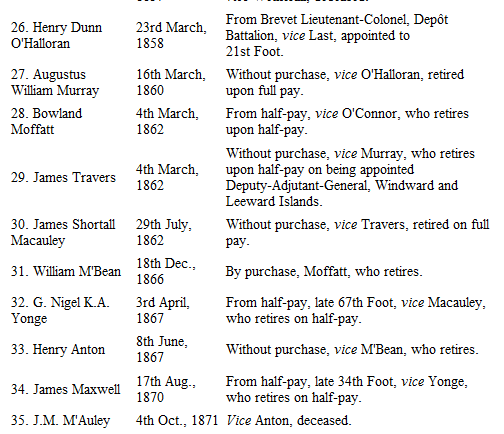
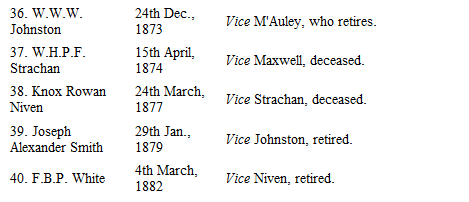
Stations of the 1st West India Regiment from June, 1795, to June, 1883.
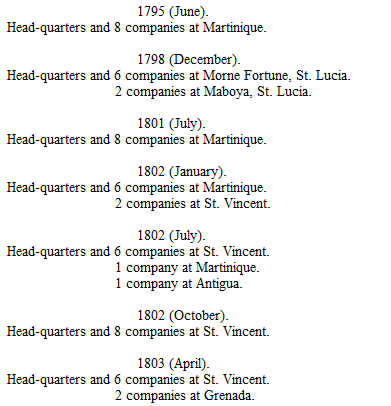

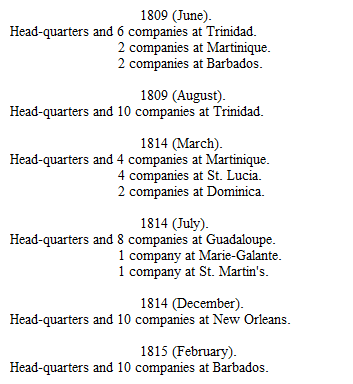
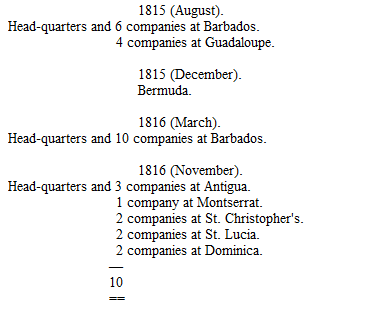
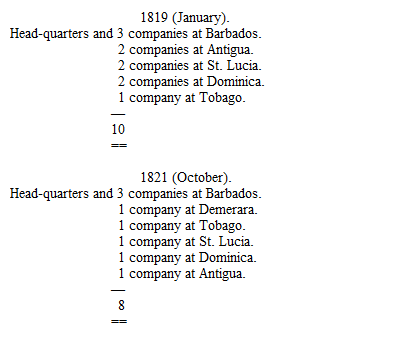
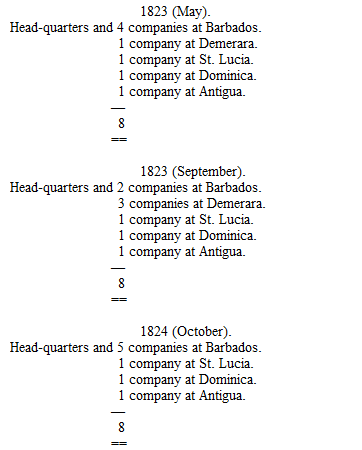

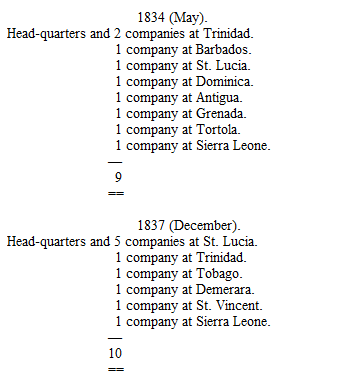
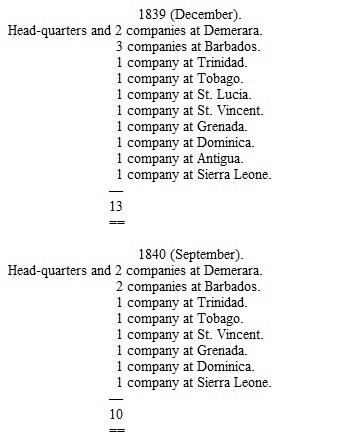
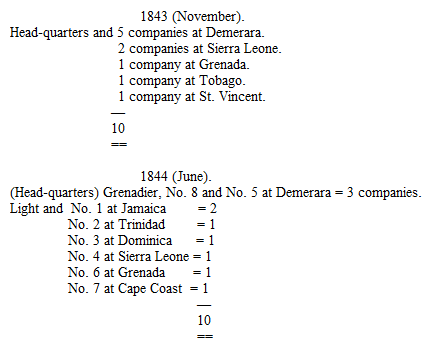
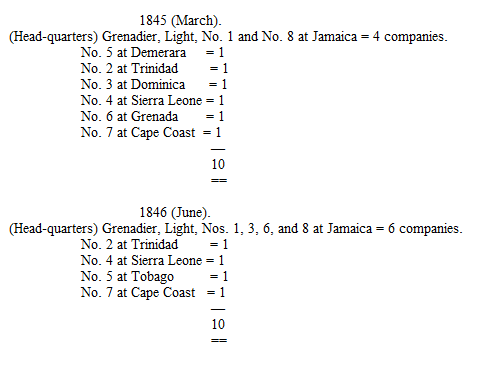

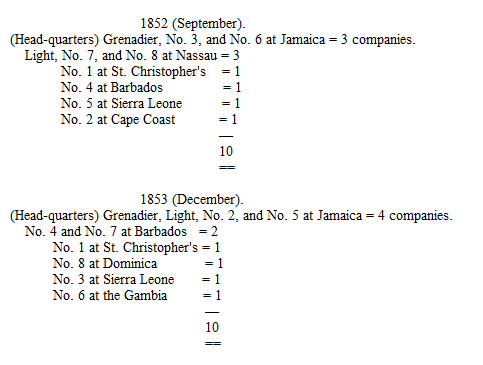
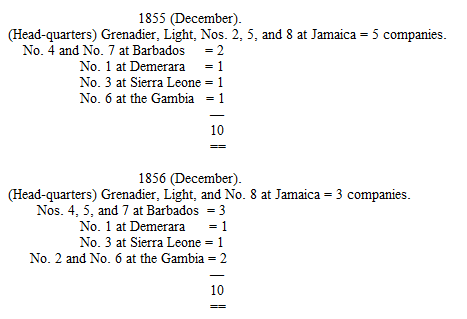


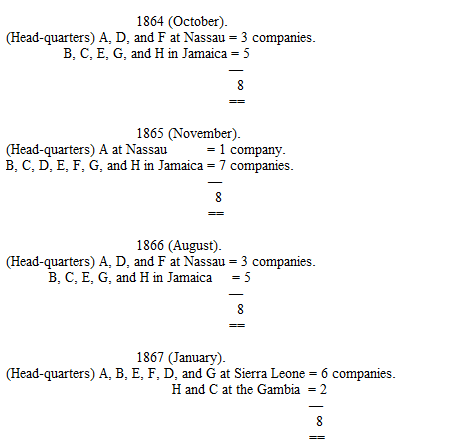
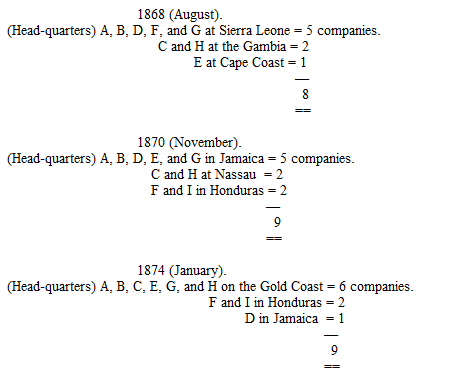

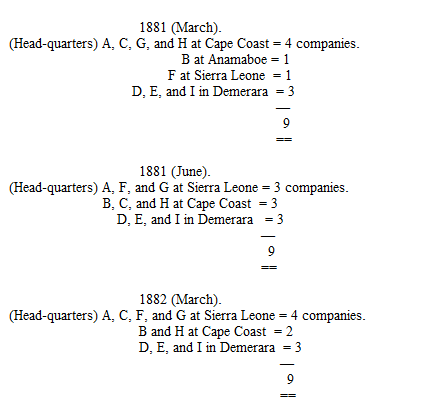

1
De Lancey's Corps, the New York Volunteers, and Skinner's Corps.
2
"Annual Register," 1779, Beatson's "Memoirs," Gordon's "History of the American War," etc. etc.
3
Beatson's "Naval and Military Memoirs," vol. iv. p. 492.
4
Major-General Prevost had come from Florida and assumed command in January.
5
"Return of the killed, wounded, and missing at the repulse of the Rebels at Stono Ferry, South Carolina, June 20th, 1779."
6
"The True History of the Siege of Savannah," published 1780.
7
"The Campaigns of 1780 and 1781, in the Southern Provinces of North America," by Lieutenant-Colonel Tarleton, London, 1787.
8
Tarleton, p. 461.
9
"Martial Register," vol. iii. p. 110.
10
See map.
11
Major-General Bruce's despatch.
12
See map.
13
Bryan Edwards.
14
See map.
15
Return of the killed, wounded, and missing in the actions on the following days, of the troops under the command of Brigadier-General Stewart, in the island of St. Lucia.
14th of April, 1795Royal Rangers – 1 sergeant, 5 rank and file, wounded.
15th of AprilRoyal Rangers – 2 rank and file, killed; 1 sergeant, 4 rank and file, wounded.
20th of AprilRoyal Rangers – 6 rank and file, killed; 1 captain, 1 sergeant, and 18 rank and file, wounded.
22nd of AprilCarolina Corps – 1 rank and file, wounded.
Royal Rangers – 4 rank and file, killed; 5 rank and file, wounded.
Names of the Officers killed and woundedCaptain Robert Malcolm, of the Royal Rangers, wounded.
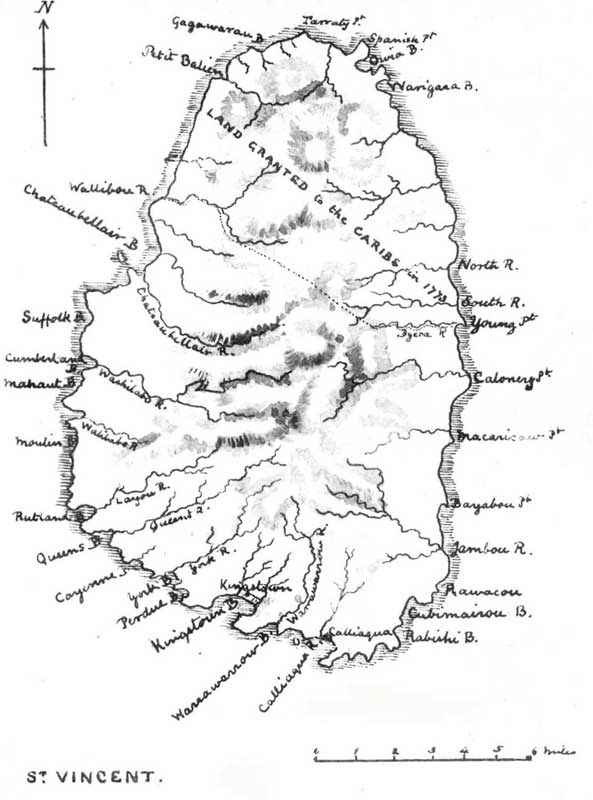
16
Coke; Bryan Edwards says the 8th.
17
Coke.
18
See next chapter.
19
In the Account of the Extraordinary Expenditure of the Army, from 25th December, 1795, to 6th December, 1796, is the following:

20
"The military force in St. Vincent consists at present of a regiment of infantry and a company of artillery, sent from England; and a black corps raised in the country, but provided for, with the former, on the British Establishment, and receiving no additional pay from the island." – Bryan Edwards, vol. i. p. 428.
21
The Army List for 1795 is dated January 1st.
22
Bryan Edwards.
23
Lowenstein's Rangers were Europeans. They were afterwards drafted into the 60th.
24
Return of killed, wounded, and missing, in the attack made on the enemy's batteries, May 3rd, 1796. Lieutenant-Colonel Malcolm's Rangers: 3 rank and file, killed; 2 rank and file, wounded; 2 captains, 1 lieutenant, 7 rank and file, missing. Lieutenant-Colonel Malcolm dead of his wounds. The names of the officers of Malcolm's returned missing, not known.
25
Raised in 1796. This corps became the 12th West India Regiment in 1799.
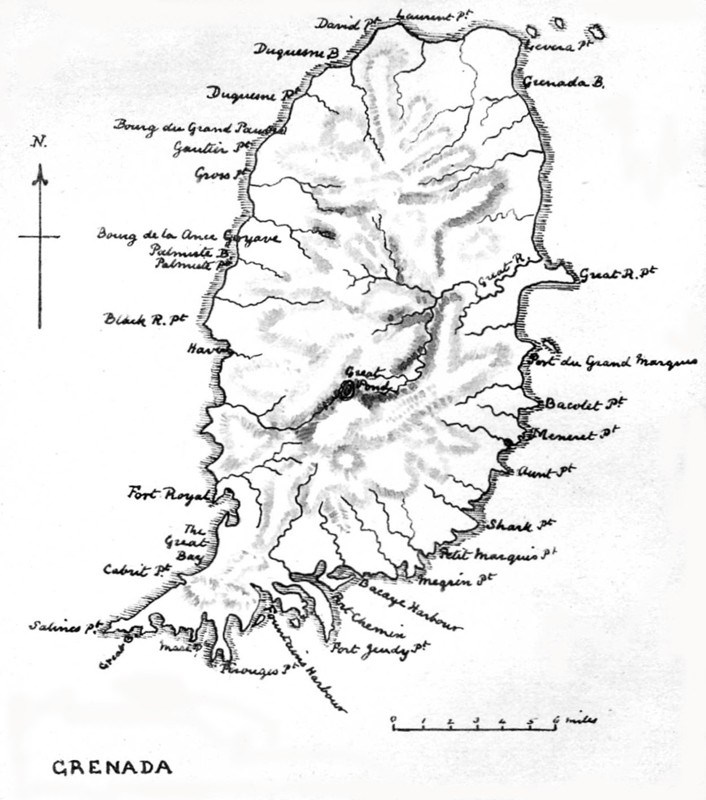
26
Bryan Edwards.
27
Bryan Edwards.
28
It is true that the 8th West India Regiment mutinied at Dominica, in 1802, but it was under conditions which, to a certain extent, extenuated it. For more than six months the men had been defrauded of their pay. Being utterly uneducated and all new negroes, they were ignorant of the proper methods of obtaining redress, and consequently showed their resentment by violence.
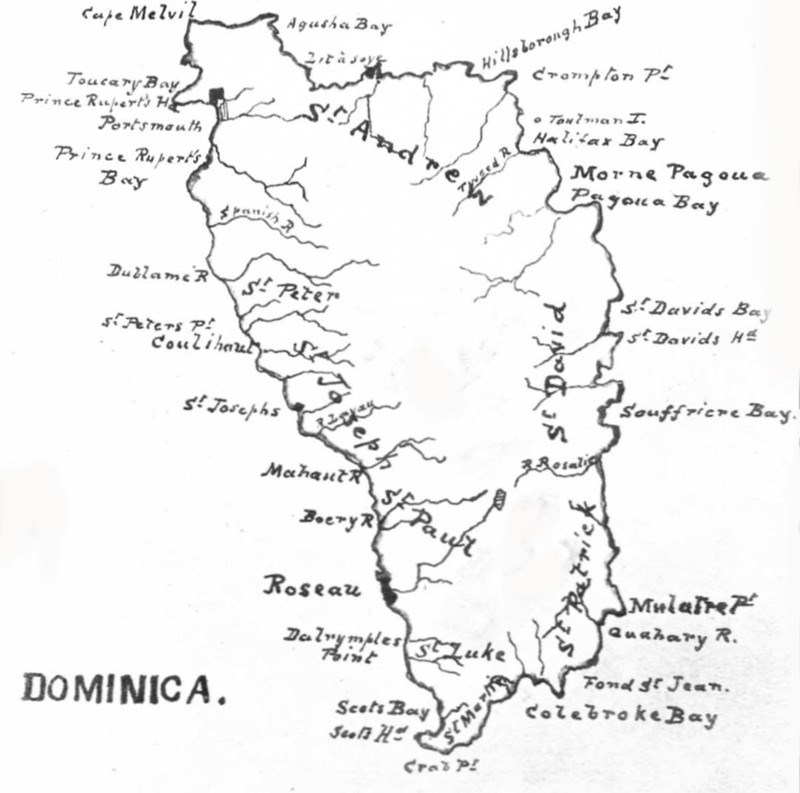
29
This does not appear in Brigadier-General Prevost's letter, but is mentioned in that of General La Grange.
30
"During a continued march of four days, through an exceedingly difficult country, that brave officer (Captain O'Connell) did not leave behind even one of his wounded men." – Bryan Edwards.
31
A summons to surrender.
32
A refusal.
33
See map of Guadaloupe.
34
Major Nathaniel Blackwell, 1st West India Regiment, was, by the Gazette of May 24th, 1808, promoted Lieutenant-Colonel of the 4th West India Regiment, for his services at the reduction of the Danish West India Islands. At this time he had not yet joined his new corps.
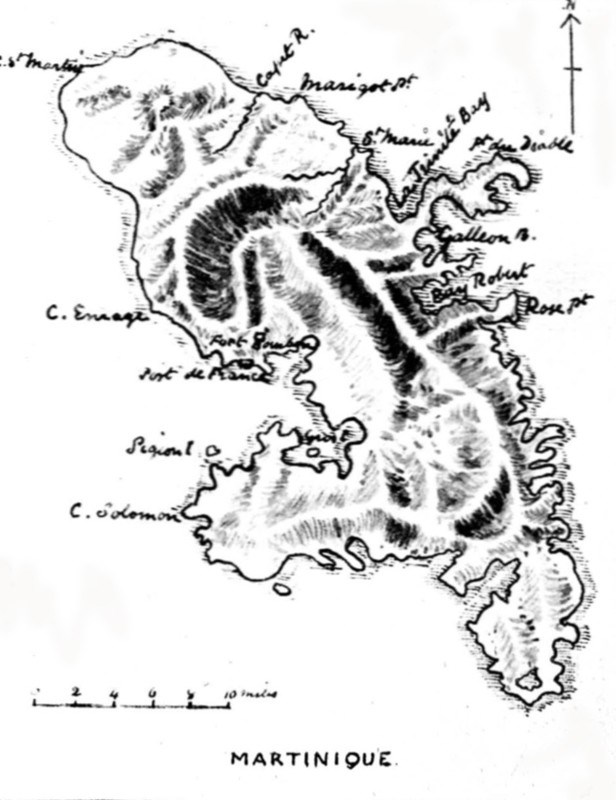
35
This island had been restored to France by the Treaty of Amiens.
36
The grenadier company of the 1st West India Regiment lost 1 rank and file, killed; 1 drummer, 18 rank and file, wounded; 1 subaltern, missing.
37
"The Campaigns of the British Army at Washington and New Orleans," by an Officer.
38
According to Major-General Lambert's despatch to Earl Bathurst, the 5th West India Regiment was to cross the river with Colonel Thornton.
39
This officer was afterwards dismissed the service.
40
The British force employed in this expedition has been thus estimated:
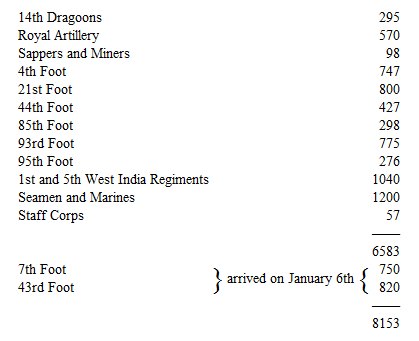
Out of the ten officers who accompanied the regiment on this ill-fated expedition one was killed, two died from exposure, and five were wounded.
41
Bryan Edwards.
42
Published in London in 1816.
43
The Mandingoes are a warlike Mohammedan tribe, inhabiting the territory inland from the Gambia River to Sierra Leone.
44
Captain Berwick, Royal African Corps; Lieutenant Lardner, 2nd West India Regiment; and Captain Hughes, Gambia Militia.
45
An account of the fatal hurricane by which Barbados suffered in 1831, published at Bridgetown, Barbados, 1831.
"Detachment 1st West India Regiment"Return of the men killed and wounded during the late hurricane, 15th August, 1831:
"Killed – Henry Read, private.
"Wounded – 4 privates.
(Signed) "H. BROCKLASS, Lieut., 1st W.I. Regt."46
Now spelt Popos.
47
The Yorubas are a warlike Mohammedan tribe living in and around Lagos. The Houssa Constabulary is largely recruited from them.
48
This is the manner in which West African savages usually fire, and it is dictated by motives of sound prudence, for the Birmingham muskets with which they are supplied by British traders are so unsafe (the barrel not uncommonly being made of old iron piping), and the charges of powder used are so immense, that the bursting of a piece is looked upon as an ordinary occurrence; and when firing they like to keep their muskets as far removed from their bodies as possible. The majority of the mutineers fired in this manner, because, having been less than three weeks in the regiment, they had not yet been drilled with arms.
49
All young ensigns just arrived from England to join the regiment.
50
Sergeant-Major D. Cantrell. He had been the first to give the alarm.
51
Eleven miles distant from San Josef.
52
Torrens was sentenced to death, but, at the intercession of Colonel Bush, the sentence was commuted to imprisonment for life.
53
The firing party was furnished by the 1st West India Regiment.
54
The companies in Jamaica were detached thus: No. 1, No. 8, and Grenadier Company at Up Park Camp. The Light Company between Port Antonio and Montego Bay.
55
The distribution in Jamaica then was:
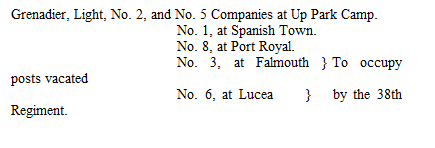
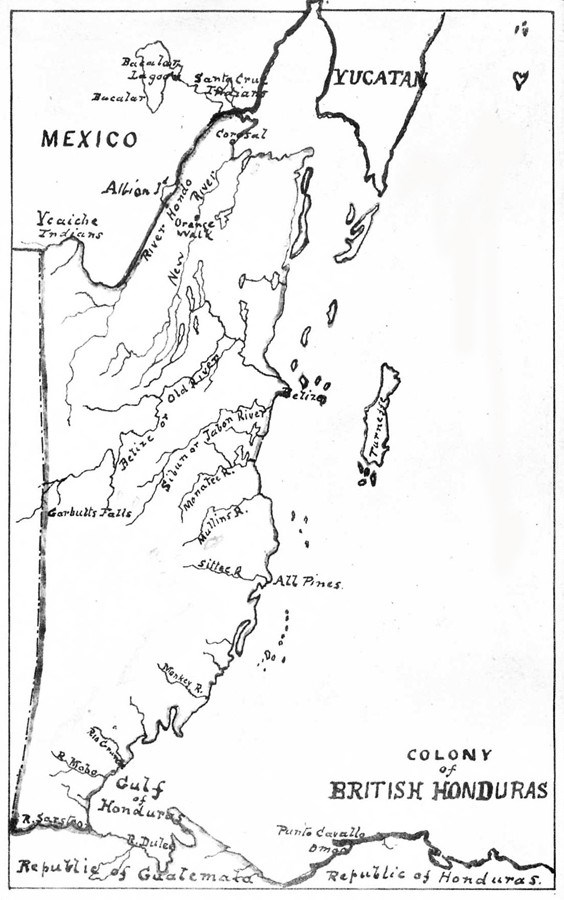
56
See map.
57
This year, 1853, appears to have been particularly unhealthy in the West Indies, to judge from the following inscription, taken from an intramural monument in Kingston Cathedral Church:
TO THE MEMORY OF THE FOLLOWING:Capt. Robt. Mostyn, 3rd W.I.R., died of yellow fever, at Nassau, Bahamas, 23rd July, 1853, æt. 27.
Ensign John Alex. Gordon Pringle, 3rd W.I.R., died of yellow fever at Kingston, Jamaica, 31st July, 1853, æt. 21.
Assist. – Surg. Walter William Harris, 1st W.I.R., attached to 3rd W.I.R., died at Up Park Camp, of yellow fever, 4th Aug., 1853, æt. 24.
Lieut. John Maryon Wilson, 3rd W.I.R., died at Up Park Camp, of yellow fever, 13th Aug., 1853, æt. 22.
Eliza Chancellor Wilson, wife of the above, died at Up Park Camp, of yellow fever, 5th Sept., 1853, æt. 22.
Cath. Elizabeth, wife of Lieut. Wm. Hen. Wilson Hawtayne, 3rd W.I.R., died of yellow fever at Nassau, Bahamas, 9th Aug., 1853, æt. 23.
Asst. – Surg. Gideon Jas. Wm. Griffith, 3rd W.I.R., died of yellow fever at Lucia, 26th Aug., 1853, æt. 23.
Also, Selina Maria, wife of Capt. C.S.H. Hingston, 3rd W.I.R., died at Up Park Camp, 11th April, 1854, æt. 23.
Erected by the officers of the 1st and 3rd W.I. Regts.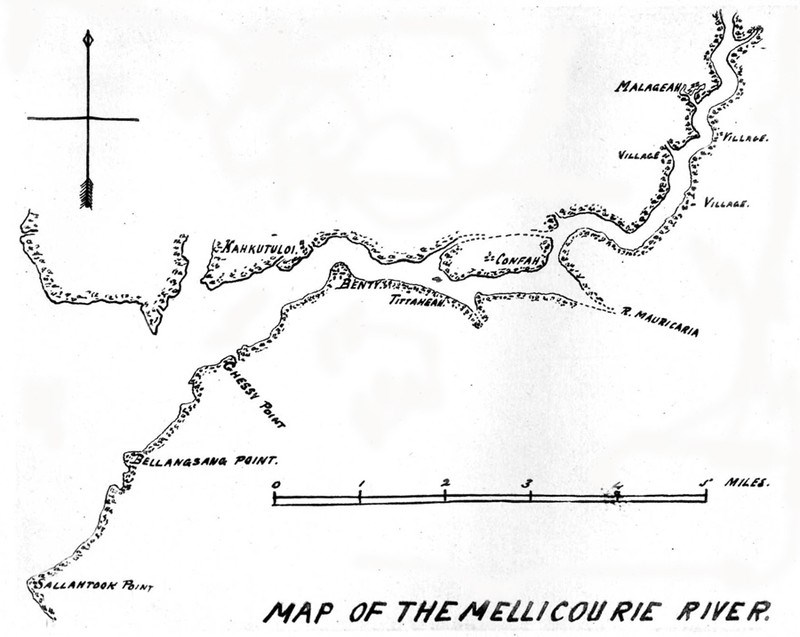
58
See map.
59
The following was the composition of the court:

60
By the Gazette of September 25th, 1867, Lieutenant R.E.D. Ness, 2nd West India Regiment, was promoted Captain, by purchase, in the 4th West India Regiment.
61
See Map.
62
Privates Hoffer, Maxwell, S. Osborne, Murray, R.A. Morris, and W. Tell.
63
Colonel Colley had arrived at the northern side of the village, from Ahkankuassie, soon after the command had devolved upon Captain Duncan.



